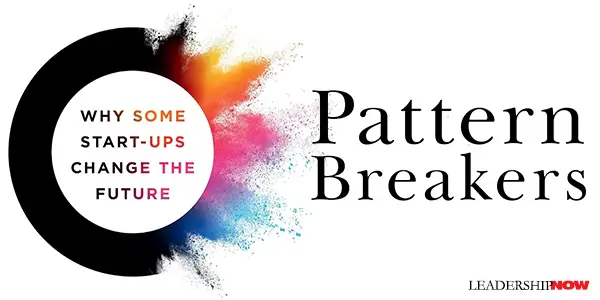 |
 |
08.27.24

Pattern Breakers
MOST people think that breakthrough ideas come from a vision of the future that is better than what we see today. It is based on the idea that the future will be a new and improved continuation of today. The vision relies on past experiences and then finding patterns that are used to predict the future. However, successful breakthrough ideas require pattern-breaking—unconventional thinking. In Pattern Breakers, authors Mike Maples and Peter Ziebelman explain how pattern breakers live in the future. This is a key idea. Most ideas about the future are an extension of today from people “living in the present, building on the norms of thinking and feeling, and acting that have been previously set by others.” This is what most of us do. In contrast, Pattern Breakers seek to “build for a future that will break from what we know today. They focus on creating a radically different future and commit to discovering inflections and insights that enable them to deliver a pattern-breaking solution.” This is difficult because you’re thinking and working in uncharted territory. And there’s nothing to unlearn. It’s all new. That brings us to two key elements of pattern breakers: inflections and insights. An inflection is an event that creates the potential for radical change in how people think, feel, and act. An insight is a nonobvious truth about how to harness one or more inflections to change human capacities and behaviors in a radical way. Together, these create the conditions for unconventional breakthrough success. Discovering an inflection and developing an insight from it is not easy. The authors offer clues on how to do it. An inflection is “an underlying change that makes an even greater change possible, one that adds to the inventory of what humans do.” For example, “livestreaming, tweeting, web surfing, and ridesharing all harnessed the power of inflections. None of these activities were possible until an inflection conferred new capacities on people.” From a start-up perspective, what makes inflections interesting is that they create an opportunity to alter the rules that govern competition in the future rather than simply improving existing products according to the current rules. Inflections are about exchanging old patterns of behavior for new ones. We tend to create within what we already know—the status quo—and so we never break the pattern to bring about breakthrough success. An insight is how one might use that inflection to change human capacities or behavior. Developing a compelling insight is the main job of the founder. From that, you come up with your idea for a product or service based on the insight. For a breakthrough success, timing is everything. Even if it has been tried before and failed, now may be the time. You may have correctly identified an inflection, but if you act too quickly to harness it, you’ve got a science project. It’s too soon to radically change human behavior. If you act too slowly, you’ve got what is a conventional idea, embraced only after it became obvious to many others—leaving your idea to compete against a crowded field. Pattern breaking is a non-consensus opportunity that forces a choice in the mind of the individual and not a comparison. A pattern-breaking idea isn’t better than the old choice; it is different. Here’s why: When you frame your story around being “better,” you inadvertently accept the existing standard set by established players. This tacitly concedes that the prevailing model defined by the status quo remains relevant. In doing so, you forfeit the opportunity to redefine the game on your terms, without fully realizing what you’ve given up. There are four tests to determine whether or not you have an insight: First, insights must be truths. Second, insights cannot be obvious. Third, insights must harness the power of inflections. And fourth, insights should answer the question, “Why now?” The book is written around start-up ventures, but the concepts are the same when developing an idea within established organizations or anything that needs reinvention. Often, what you see leaders doing is making incremental improvements on what worked before with little success because the playing field has shifted. Essentially, we are improving on what we have done before, which was designed for a world that no longer exists. What is called for is pattern pattern-breaking approach that comes from the future and is not tethered to the past. The enemy is the status quo. Key Reminders for Implementation By spreading too thin over numerous benefits, you risk being forgettable or failing to effectively communicate any one compelling reason for early customers to engage. 
Posted by Michael McKinney at 05:34 PM
|
BUILD YOUR KNOWLEDGE
 

How to Do Your Start-Up Right STRAIGHT TALK FOR START-UPS 
Grow Your Leadership Skills NEW AND UPCOMING LEADERSHIP BOOKS 
Leadership Minute BITE-SIZE CONCEPTS YOU CAN CHEW ON 
Classic Leadership Books BOOKS TO READ BEFORE YOU LEAD |